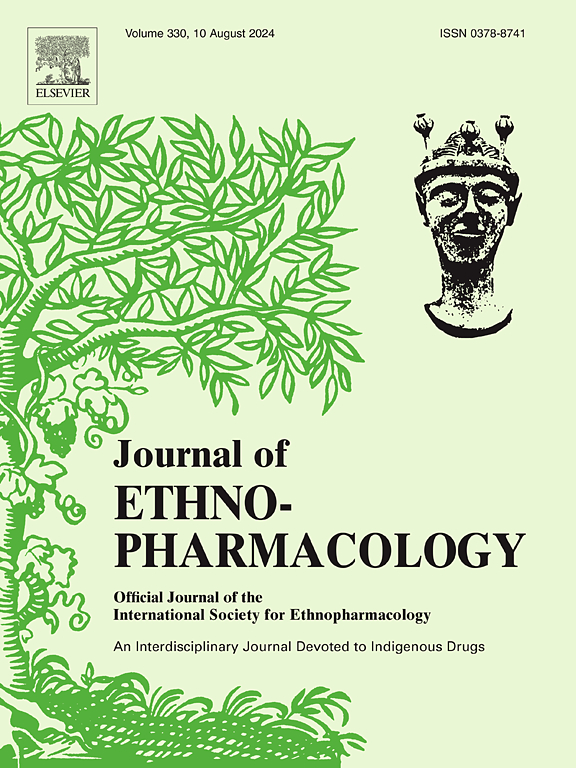Integrating single-cell analysis and machine learning to identify COPD hub genes and explore the intervention mechanism of effective component compatibility of Bufei Yishen formula III
IF 4.8
2区 医学
Q1 CHEMISTRY, MEDICINAL
引用次数: 0
Abstract
Ethnopharmacological relevance
Chronic obstructive pulmonary disease (COPD) is a prevalent condition that poses a major threat to public health. Endothelial cells play a critical role in COPD pathogenesis. Recent evidence suggests that the effective-component combination of Bufei Yishen formula III (ECC-BYF III) significantly improves clinical symptoms and quality of life in COPD patients.
Aim of the study
To identify endothelial cell-associated hub genes in COPD using single-cell analysis and machine learning, and to elucidate the intervention mechanism underlying ECC-BYF III.
Materials and methods
Single-cell analysis was used to identify altered cellular subtypes in COPD samples. High-dimensional weighted gene co-expression network analysis (hdWGCNA) and multiple machine learning algorithms were applied to identify COPD-related hub genes. These genes were validated using receiver operating characteristic (ROC) curves, independent datasets, qRT-PCR in human umbilical vein endothelial cells (HUVECs) and a rat model of COPD.
Results
Single-cell analysis revealed nine distinct cell subtypes, with endothelial cells markedly reduced in COPD samples compared to controls. Cell communication and pseudotime trajectory analysis highlighted the role and developmental trajectory of endothelial cells in COPD. Differential expression analysis and hdWGCNA identified 269 endothelial cell–associated genes, from which six hub genes were selected via machine learning. qRT-PCR confirmed that CD74, AQP1, SOX4, and ANXA1 were significantly dysregulated in both HUVECs and COPD rat models, consistent with the data analysis results. Notably, ECC-BYF III intervention reversed these gene expression abnormalities. Molecular docking demonstrated that the components of ECC-BYF III exhibited strong binding affinities for the hub genes.
Conclusions
Four hub genes (CD74, SOX4, AQP1, and ANXA1) involved in the pathogenesis of endothelial cells in COPD were identified. ECC-BYF III was shown to modulate their expression, supporting its potential as a therapeutic agent in traditional Chinese medicine (TCM) for COPD. These findings offer novel insights into the mechanisms of COPD and open avenues for TCM treatment.

将单细胞分析与机器学习相结合,鉴定COPD枢纽基因,探索补肺益肾III方有效成分配伍的干预机制。
民族药理学相关性:慢性阻塞性肺疾病(COPD)是一种对公众健康构成重大威胁的普遍疾病。内皮细胞在COPD发病中起关键作用。最近有证据表明,补肺益肾方III (ECC-BYF III)有效组分联合治疗可显著改善慢性阻塞性肺疾病患者的临床症状和生活质量。研究目的:利用单细胞分析和机器学习技术鉴定COPD中内皮细胞相关中枢基因,并阐明内皮细胞- byf III的干预机制。材料和方法:单细胞分析用于鉴定COPD样本中改变的细胞亚型。采用高维加权基因共表达网络分析(hdWGCNA)和多种机器学习算法鉴定copd相关中心基因。这些基因通过受试者工作特征(ROC)曲线、独立数据集、人脐静脉内皮细胞(HUVECs)和COPD大鼠模型的qRT-PCR进行验证。结果:单细胞分析揭示了9种不同的细胞亚型,与对照组相比,COPD样本中的内皮细胞明显减少。细胞通讯和伪时间轨迹分析强调了内皮细胞在COPD中的作用和发育轨迹。差异表达分析和hdWGCNA鉴定了269个内皮细胞相关基因,通过机器学习从中选择了6个中心基因。qRT-PCR证实,CD74、AQP1、SOX4和ANXA1在HUVECs和COPD大鼠模型中均显著失调,与数据分析结果一致。值得注意的是,ECC-BYF III干预逆转了这些基因表达异常。分子对接表明,ECC-BYF III的组分对枢纽基因具有较强的结合亲和力。结论:发现了4个中枢基因(CD74、SOX4、AQP1和ANXA1)参与COPD内皮细胞的发病机制。研究显示,ECC-BYF III可以调节它们的表达,支持其作为COPD中药治疗剂的潜力。这些发现为COPD的发病机制提供了新的见解,并为中医药治疗开辟了新的途径。
本文章由计算机程序翻译,如有差异,请以英文原文为准。
求助全文
约1分钟内获得全文
求助全文
来源期刊

Journal of ethnopharmacology
医学-全科医学与补充医学
CiteScore
10.30
自引率
5.60%
发文量
967
审稿时长
77 days
期刊介绍:
The Journal of Ethnopharmacology is dedicated to the exchange of information and understandings about people''s use of plants, fungi, animals, microorganisms and minerals and their biological and pharmacological effects based on the principles established through international conventions. Early people confronted with illness and disease, discovered a wealth of useful therapeutic agents in the plant and animal kingdoms. The empirical knowledge of these medicinal substances and their toxic potential was passed on by oral tradition and sometimes recorded in herbals and other texts on materia medica. Many valuable drugs of today (e.g., atropine, ephedrine, tubocurarine, digoxin, reserpine) came into use through the study of indigenous remedies. Chemists continue to use plant-derived drugs (e.g., morphine, taxol, physostigmine, quinidine, emetine) as prototypes in their attempts to develop more effective and less toxic medicinals.
 求助内容:
求助内容: 应助结果提醒方式:
应助结果提醒方式:


